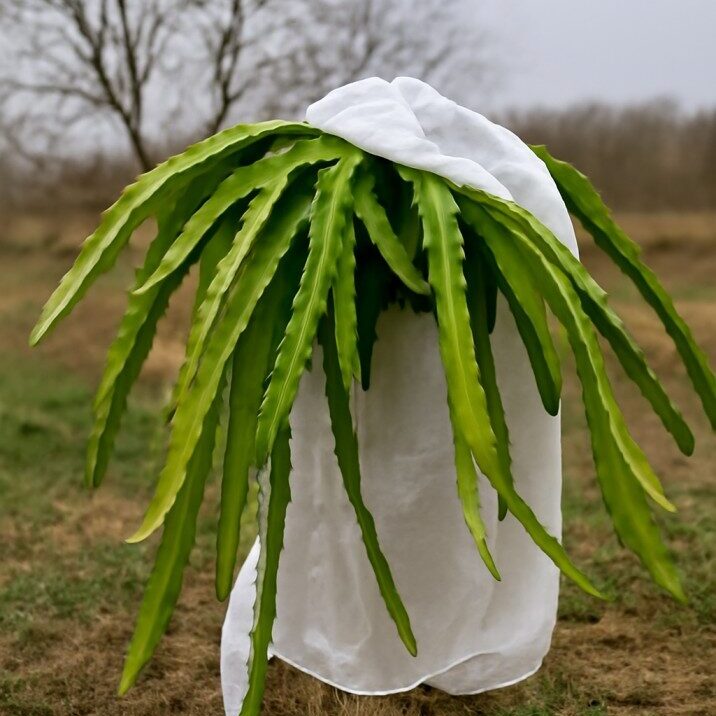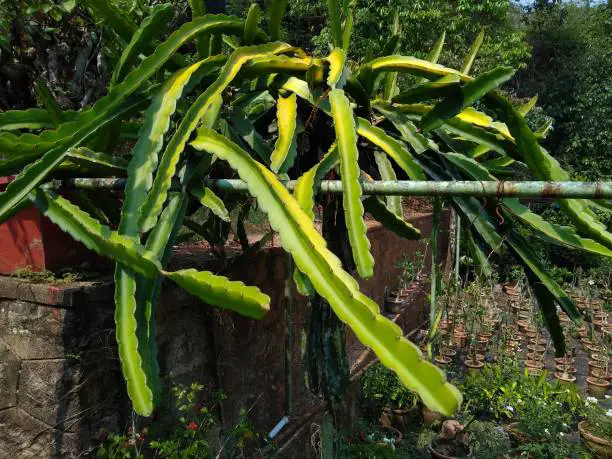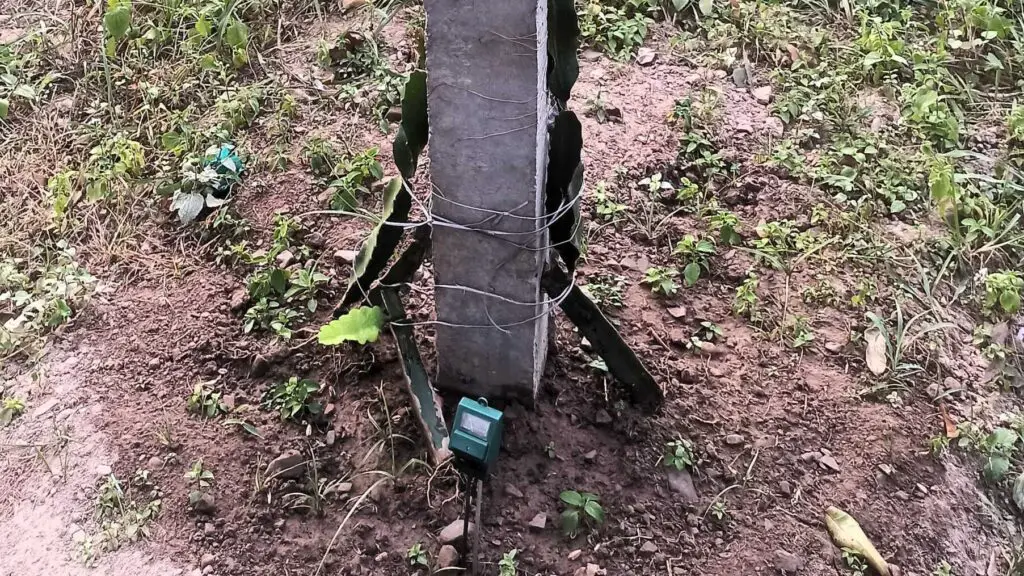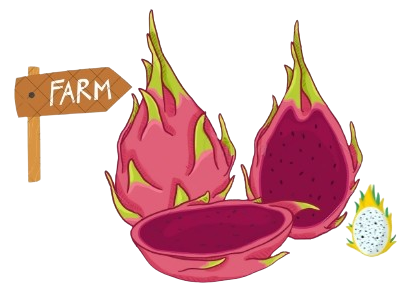Dragon fruit farming is rapidly growing in India, but if you are in the northern part of the country, winter can be a challenging time for your dragon fruit plants. From December 15 to February 15, the cold weather can be especially hard on dragon fruit, as they are tropical plants that need warm, humid conditions to grow well. This article will guide you on dragon fruit plant winter care, ensuring they stay healthy and productive despite the cold.
Dragon fruit plant winter care: Understanding Winter Needs

Dragon fruit plant winter care, being tropical, require warmth to grow. When the temperature drops below 10°C, these plants go into a kind of hibernation, meaning their growth stops. This is when they need extra care to protect them from cold damage and potential diseases. The cold weather makes dragon fruit plants more vulnerable to fungal infections, stress, and slow recovery. Here’s a breakdown of the common problems dragon fruit faces in winter and how you can tackle them.
How to protect dragon fruit in winter – Main challenges
1. Fungal Infections
- Problem: Winter brings higher humidity and cold, which creates the perfect environment for fungi to thrive. Dragon fruit plants, especially their roots and new branches, are most affected by these infections. When moisture remains in the soil for too long, it encourages fungus growth. In cold temperatures, plants are also less able to fight off these infections, which can halt their growth and even weaken their roots.
- Solution: To protect your dragon fruit plants from fungal infections, it’s essential to keep the soil clean and dry. Regularly check for signs of fungus and use the right fungicides. You can spray your plants with a schedule every 10-15 days using contact fungicides, systemic fungicides, or even natural treatments like Trichoderma, which helps fight fungal growth without chemicals.
2. Stress and Yellowing of Leaves
- Problem: The drop in temperature causes dragon fruit plants to experience stress, making them unable to absorb nutrients as efficiently. As a result, their leaves may turn yellow, indicating weakness. This is a sign that your plant is struggling to stay healthy due to the cold.
- Solution: To reduce stress, provide your plants with warm compost, such as chicken or goat manure. These manures are rich in nitrogen, phosphorus, and potassium, which are essential nutrients for the plant’s health. Keeping the soil balanced with the right nutrients will help your plant stay strong and reduce the risk of yellowing leaves.
3. Slow Recovery During Winter
- Problem: Dragon fruit plants enter a dormant phase during the winter, which slows down their recovery from any damage caused by the cold or diseases. When the plants are in this hibernation-like state, repairing their cells and growing new parts is much slower, which can delay recovery if they get sick.
- Solution: To help your plants recover faster, provide them with proper care, including adequate nutrition and protection from pests and diseases. If you notice signs of damage, act quickly with the right treatment to prevent the plant from becoming too weak to bounce back.
Importance of Fertilizing Dragon Fruit During Winter

Why Use Chicken or Goat Manure?
- Problem: dragon fruit plant problems – The cold weather slows down the activity of your plant’s roots. Without the right nutrition, the roots can weaken, which affects the plant’s growth in the coming months. The manure helps to nourish the roots and provide warmth to the soil.
- Solution: Chicken and goat manure are excellent for winter months because they release nutrients slowly, which keeps the roots fed during the cold. This manure is rich in essential nutrients such as nitrogen (for strong stems and leaves), phosphorus (for healthy roots), and potassium (to help the plant fight cold stress and diseases).
How to Use Manure Properly
- Problem: Directly applying manure without preparation can burn the roots or not be effective.
- Solution: Make sure to mix the manure with the soil properly, and apply it in small doses. You can add it around the base of the plant, avoiding direct contact with the roots, and allow it to break down in the soil. This way, your plants can absorb the nutrients as needed.
Dealing with Winter Rains

The Problem with Excess Moisture
- Problem: Winter rains can cause waterlogging around your dragon fruit plant problems. When there’s too much water in the soil, the roots may not get enough oxygen, making them weak. Excess moisture also creates the perfect conditions for fungi to grow, leading to potential root rot or stem rot.
- Solution: To avoid waterlogging, make sure your field has proper drainage. Create small mounds or raised beds to allow water to flow away from the roots. Use fungicides regularly to protect your plants from any fungal issues caused by the rain.
Controlling Movement in the Field
Why Limiting Movement Is Crucial
- Problem: Excessive movement in the field can spread diseases from one plant to another. Fungi and bacteria can travel through shoes, clothes, and tools, which may cause problems for your plants.
- Solution: Limit the number of people entering the field, and make sure anyone who does enters with clean shoes and tools. Regularly inspect the field and remove any decaying plant parts to reduce the spread of diseases.
Bonus Tip for Farmers:
Make sure to protect your plants from frost -dragon fruit plant winter care – by covering them with sheets or cloth during extremely cold nights. This will help to trap some warmth and keep your plants safe. It’s a simple but effective way to minimize the effects of sudden drops in temperature.
Conclusion
dragon fruit plant winter care during the winter in colder regions of India requires special attention and care. With the right steps to manage fungal infections, stress, slow recovery, and appropriate fertilization, you can ensure healthy growth even in the colder months. By following a set schedule for care, your plants will thrive, and you will be able to grow dragon fruit even in regions where the temperatures drop.
Frequently Asked Questions (FAQs)
Q1: How much cold can dragon fruit plants tolerate?
A1: Generally, dragon fruit plant winter care can survive temperatures as low as 10°C, but some varieties can tolerate even colder temperatures, down to about 2°C.
Q2: When should I fertilize dragon fruit plants in winter?
A2: It’s best to fertilize dragon fruit plants before December 15, using organic fertilizers like chicken or goat manure.
Q3: Can rain during winter affect dragon fruit plants?
A3: Yes, excessive rain can cause waterlogging, which leads to weak roots and fungal infections. Ensure proper drainage in the field to prevent these issues.
Q4: What is the best fungicide to use for dragon fruit plants?
A4: Use a combination of contact and systemic fungicides, such as Trichoderma and Nativo spray, to effectively protect your plants from fungal infections.
Q5: How do I prevent yellow leaves in dragon fruit plants during winter?
A5: To prevent yellowing, ensure your plants receive proper nutrition through organic fertilizers and manage stress factors like temperature and water levels.
Q6: Can dragon fruit plants recover from damage caused by cold weather?
A6: Recovery can be slow, but with the right care, such as proper nutrition and protection from diseases, dragon fruit plants can bounce back after cold damage.
Q7: How can I improve the soil quality for dragon fruit plants during winter?
A7: Use organic manure, like chicken or goat manure, to improve soil fertility and provide essential nutrients to the plants.
Q8: How often should I check my dragon fruit plants for diseases during winter?
A8: Check your plants every 10-15 days for signs of disease or fungal infection and apply the necessary treatments.
Q9: Can I still harvest dragon fruit during winter?
A9: Harvesting may slow down during winter due to the plant’s dormancy, but with good care, it is still possible to get some fruit.
Q10: how to protect dragon fruit in winter from frost?
A10: Use cloth or sheets to cover your plants during cold nights to protect them from frost and keep them warm.
By taking the right steps to care for your dragon fruit plants, you can enjoy a healthy harvest, even in colder conditions. Keep these tips in mind, and your plants will stay strong and productive!
NOTE: Dragon fruit plants are indeed tropical plants and are not well-suited to cold weather. They thrive in warm, humid climates and struggle to survive when temperatures drop below 10°C. However, with proper care and management, you can still grow dragon fruit in cooler regions by implementing certain strategies to protect the plants from the cold.
Here are some effective ways to manage dragon fruit plants in cold weather:
1. Polyhouse for Temperature Control
- A polyhouse (or greenhouse) is one of the best solutions for growing dragon fruit in cold climates. It helps trap heat and maintain a controlled environment where the plants can stay warm even during the coldest months. The polyhouse acts as a barrier to harsh weather conditions, keeping the plants protected from frost, wind, and extreme cold temperatures.
- The structure also helps in maintaining humidity levels, which is essential for the health of dragon fruit plants. Ensure the polyhouse is ventilated properly to prevent excess moisture buildup, which could lead to fungal infections.
2. Shade Net for Protection
- A shade net is another excellent option to protect dragon fruit plants from cold temperatures. It provides a protective cover against frost, helps reduce the impact of strong winds, and can also provide the right amount of sunlight while shielding the plants from excessive cold.
- By adjusting the density of the shade net, you can manage the level of protection based on the severity of the weather. For extremely cold temperatures, you can use a thicker shade net to offer more protection.
3. Kaolin Clay Spray for Frost Protection
It also helps reduce water loss from the plant and protects it from stress caused by low temperatures. Kaolin clay can be an excellent tool for maintaining the plant’s health during the winter months.
Kaolin clay is a natural, non-toxic material that can be sprayed on the leaves and stems of the dragon fruit plant to create a protective layer against frost. This spray helps reflect sunlight and keeps the plants warmer by preventing the direct contact of cold air with the plant tissues.


1 thought on “Dragon Fruit Plant winter Care & Tips”